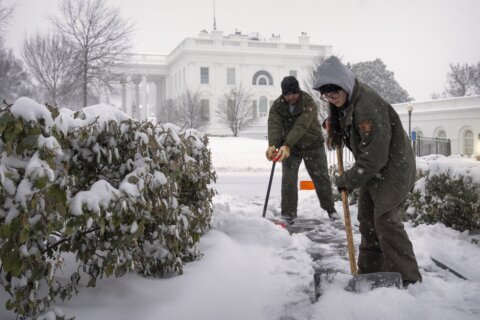Snow can make the most mundane of landscapes awe-inspiringly beautiful, but it can also make the most mundane of tasks exceedingly dangerous.
So as the flakes fall and snow piles nearly as high as a foot in parts of the D.C. region Monday, officials are urging people to follow the tips below to stay safe while driving in, shoveling through, or even just walking on the snow.
Here’s what you need to know.
Driving through the winter weather
This video is no longer available.
On a day when most of the region was home from work and school and traffic was at an absolute minimum, Maryland State Police said they still dealt with hundreds of calls — many of them for crashes and fender benders, or even vehicles that were abandoned on the side of the road.A single snow day was nice, but many people figure to be back on the job on Tuesday. With more traffic on roads that still won’t be in tiptop shape, it’s important to keep a few things in mind so that you, or someone driving next to you, also doesn’t need to call police for help.
“First and foremost, if you have to go out, make sure that you remove all of the snow from your vehicle,” Ragina Ali, spokeswoman for AAA, said. “That includes from your roof, your hood, your trunk. While driving, snow can blow off a car and into the windshield of a nearby vehicle, temporarily blinding another driver.”
Don’t let the wind and air that sweeps over your car as you drive do the work for you. By that point, it’s not just snow anymore — it can be mixed with ice.
“That is very dangerous, becoming sort of this projectile of ice definitely could crack another driver’s windshield,” Ali said.
Taking your time before you leave doesn’t mean you should try to make up time on the road, either. D.C.-area roads are bound to be fraught with icy spots for the next few days.
“When you hit a slick spot, you actually want to control that skid,” Ali said. “So you ease off the accelerator and steer into the direction that you want the front of your car to go.”
And do it subtly, because if you jerk the wheel too hard in a moment of panic, it could lead to a bad overcorrection and further skidding. And don’t use cruise control where ice might be an issue.
In fact, plan on driving slower than you normally would anyway.
You’re supposed to keep 3-4 seconds of space between you and the driver you’re following in good conditions. Extend it to 8 to 10 seconds when the roads are still messy.
Remember, sand and cat litter can provide a little extra traction if you do get stuck. If someone else along the way got stuck, move a full lane over as you drive past, just to be safe. It’s required by law anyway.
Also — just in case — have an emergency kit with you that includes a blanket, some snacks and some water.
You probably won’t need it, but isn’t that what all those drivers stuck on I-95 in Virginia in 2022 thought as well?
Navigating snowy sidewalks
Shoveling snow is one of those wintertime activities that reminds people of just how fit — or not fit — they may be.
“Be aware that shoveling snow is an intense and vigorous form of exercise,” Dr. Jennifer Gourdin, sports medicine doctor with Kaiser Permanente, told WTOP.
She advised warming up for it, as you would any serious workout, and suggested starting with a light jog, “or some dynamic stretches, like high knees or lateral lunges, to get your body ready.”
Gourdin said the way you grip the shovel can be the difference between finishing the job with just a few sore muscles or with an injury.
Hold the shovel close to your body, she said, and push the snow, instead of lifting it.
“Pushing the snow will put less strain on your back, and you’ll be less likely to injure yourself.”
She also said avoid the temptation to twist as you unload the shovel, again focus on pushing snow off the pathway or driveway. Shoveling smaller amounts at a time, she said, can help you be “less likely to overexert yourself and cause a muscle strain.”
For some people, shoveling should be avoided altogether.
“If you have a history of heart disease, or any chronic medical problems, you should always consult your doctor before doing an extensive amount of shoveling,” Gourdin said.
In those cases, you may want to look into volunteer groups in your area that offer to shovel snow for residents who can’t tackle the job themselves.
”You can also consider other alternatives like snowblowers, or things to help minimize the amount of effort that you’re going to have to exert to remove the snow,” Gourdin said.
Even on shoveled areas, just walking during and after snowstorms can be treacherous.
Making your way through the snow safely starts with good footwear, Gourdin said.
“You want to make sure you’re wearing nonslip, rubber-soled shoes, so that you have good traction in the snow and ice.”
How you walk, Gourdin said, can also make a difference.
“You walk safely by taking small steps. Short, shuffling kind of steps can help you to maintain your balance so you’re less likely to fall,” she said. “You can also think like walking like a penguin.”
Anywhere there are handrails, use them, and keep your walkways clear.
Keep in mind, refreezing can make surfaces very slick, so keep the rock salt or other snowmelt materials handy.
If you do take a tumble, don’t hesitate to get yourself checked out. Even if you don’t strike your head as you fall, you may still need to get seen by a doctor.
“If you fall back, just the jolting motion that can happen with your head and your neck can lead to something like a concussion,” Gourdin said.
For symptoms such as dizziness, light-headedness, nausea or vomiting, Gourdin said, “You definitely need to be evaluated by a doctor.”
Get breaking news and daily headlines delivered to your email inbox by signing up here.
© 2025 WTOP. All Rights Reserved. This website is not intended for users located within the European Economic Area.








